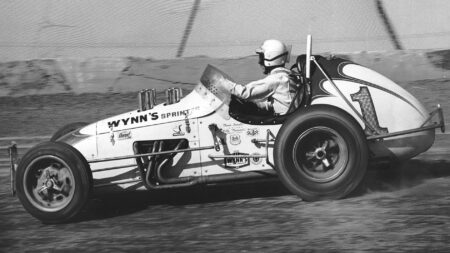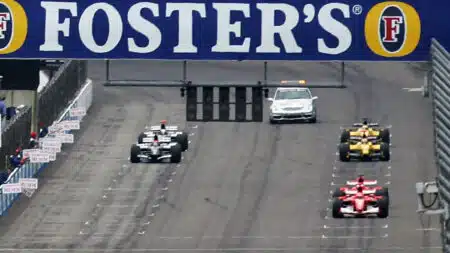I enjoyed that drive enormously, trucking south on Interstate 65, and you will be pleased to hear that the Ram and I both made it to Indianapolis unmolested and undamaged. So what about the circuit, which I first saw the following day (i.e. the Friday)? Well, it was the Brickyard alright, albeit only half of it, plus an all-new infield section consisting of a series of too-fiddly corners, resulting in a 13-turn layout of 2.604 miles (4.192km). I remember Adrian Newey, then a McLaren man, muttering wistfully that he would have relished the challenge of working with Bridgestone to prep his F1 cars to race at average lap speeds north of 200mph (322km/h) on the pukka oval version of the famous super-speedway; but, with hindsight, and bearing in mind what happened in 2005, when the speeds and forces on the Indy banking were too high for Michelin’s F1 tyres to cope with safely, I think we can be forgiven for thanking God, or Max Mosley, or Bernie Ecclestone, or someone, that no such challenge was entertained.
Besides, if I may tweak the fine words of the 19th-century British poet Robert Browning, at Indianapolis in 2000 God was in his heaven and all was right with the F1 world. Or, to put it more prosaically, the drivers and team personnel were palpably happy to be in the United States of America, they acknowledged Indianapolis’s historical significance, and they enjoyed the Brickyard’s razzmatazz. Having said that, lest we forget, what mattered to them more than any of that was that the 2000 United States Grand Prix was the 15th round of a closely fought 17-race F1 world championship. And it really was close. McLaren’s Mika Häkkinen, the defending two-time world champion, was leading the drivers’ standings on 80 points, just two points ahead of Ferrari’s Michael Schumacher on 78. So things were tight, very tight, but, going into Indy, Häkkinen had the benefit of momentum, for he had won three of the previous five grands prix to Schumacher’s one, and many pundits therefore had the McLaren man as favourite. But Michael had won last time out, at Monza. Indy would be pivotal.

Schumacher and Häkkinen at Monza where the McLaren driver started to lose his grip on the title
DPPI
In-season testing was extensive in F1 in those days, whereas now it is non-existent. In the week before the teams had flown to Indianapolis, Ferrari, McLaren, and Sauber had tested at Mugello (and Ferrari additionally at Fiorano, its private test track, as always back then); Benetton and Williams had tested at Estoril; BAR, Jaguar, and Jordan had tested at Silverstone; Minardi had tested at Vairano; and only Arrows and Prost had not tested at all. It was hardly surprising, therefore, that Prost’s drivers Jean Alesi and Nick Heidfeld, and Arrows’ Pedro de la Rosa and Jos Verstappen, struggled in FP1 and FP2; nor were many eyebrows raised when Ferrari dominated FP1 and McLaren ruled FP2; and the next day, it shocked no-one to see the same four cars qualify on the front two rows, Schumacher on the pole for Ferrari, ahead of the McLaren pair, albeit David Coulthard ahead of Häkkinen, and Schumacher’s Ferrari team-mate Rubens Barrichello in P4.
However, before that, on the Friday evening, my friend Nigel Roebuck, now retired but a brilliant F1 journalist back in the day, had suggested that I accompany him to the nearby Indiana State Fairgrounds Speedway, a one-mile dirt oval, to watch the Hoosier Hundred, which had originally been scheduled to run in late May, in the lead-up to the Indy 500, but had been postponed owing to rain. Never having clapped eyes on sprint cars or midget cars, I jumped at the chance. The race was won by sprint/midget legend Tony Elliott, a genuine Hoosier (i.e. a native of Indiana), who would be killed in a light aircraft crash in 2015, aged 54, having won 26 sprint car races, 11 midget car races, five ‘silver crown’ races, and two USAC national titles. But what I remember most vividly about that evening is being instructed via a Tannoy announcement to “join hands with your neighbour and pray to Jesus” before the start of the race. I tried to do just that, holding Roebuck’s hand on one side and the hand of a scruffy, mulleted stranger on the other.

Coulthard becomes the first driver to lead a Formula 1 race at Indianapolis. But not for long
LAT
Returning to F1, on race-day morning early rain had left the track surface damp; a few hours later the fast-drying asphalt was now forcing the teams’ engineers to calculate, recalculate, and recalculate again the optimal lap on which to switch from wets to slicks. When the five red lights finally went out on the startline gantry, the track had dried, and Coulthard appeared to get away very well, taking the lead, but a few laps later he was served a 10-second stop-go penalty for jumping the start. However, that mattered not as far as Schumacher was concerned, for he was at his most relentless: on lap seven he passed Coulthard around the outside under braking for the first corner, minding not that the Ferrari and the McLaren had momentarily touched, then he put the hammer down and sped away from the field.
After the first round of pitstops Schumacher led Häkkinen by a quarter of a minute. Was Mika done and dusted? The answer was no. By one-third distance, having rattled off a consecutive series of inspired fastest laps, he had cut Michael’s lead down to a smidgen over four seconds. Could he win? Perhaps he could, or perhaps he could not — we will never know — because, on lap 26, first he felt then he saw (in his mirrors) his McLaren’s Mercedes V10 expire in flames, which disaster wrested from him the F1 drivers’ world championship lead there and then.




